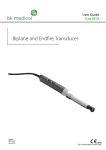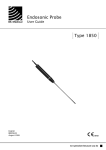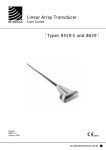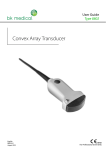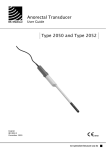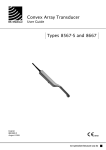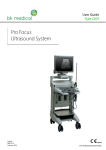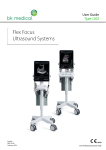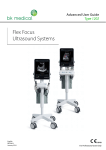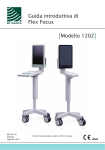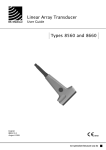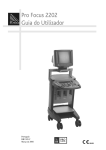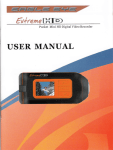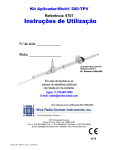Download BK Medical 8805 User guide
Transcript
User Guide Type 8808 Biplane Transducer English BB0339-M June 2012 For Professional Users Only BK MEDICAL Mileparken 34 2730 Herlev Denmark Tel.:+45 4452 8100 / Fax:+45 4452 8199 www.bkmed.com Email: [email protected] The serial number of a BK Medical product contains information about the year of manufacture. To obtain the date of manufacture of a product, please contact your BK Medical representative or write to us at the email address above, including the product’s serial number (SN number). BK Medical Customer Satisfaction Input from our customers helps us improve our products and services. As part of our customer satisfaction program, we contact a sample of our customers a few months after they receive their orders. If you receive an email message from us asking for your feedback, we hope you will be willing to answer some questions about your experience buying and using our products. Your opinions are important to us. You are of course always welcome to contact us via your BK Medical representative or by contacting us directly. If you have comments about the user documentation, please write to us at the email address above. We would like to hear from you. © 2012 BK Medical Information in this document may be subject to change without notice. Contents Introduction . . . . . . . . . . . . . . . . . . . . . . . . . . . . . . . . . . . . . . . . . . . . . . . . . . . . . . 5 Indications for Use . . . . . . . . . . . . . . . . . . . . . . . . . . . . . . . . . . . . . . . . . . . . . 5 General Information . . . . . . . . . . . . . . . . . . . . . . . . . . . . . . . . . . . . . . . . . . . . . . . 6 Service and Repair . . . . . . . . . . . . . . . . . . . . . . . . . . . . . . . . . . . . . . . . . . . . . 7 Caring for the Transducer. . . . . . . . . . . . . . . . . . . . . . . . . . . . . . . . . . . . . . . . 7 Cleaning and Disinfection . . . . . . . . . . . . . . . . . . . . . . . . . . . . . . . . . . . . . . . . . . . 7 Starting Imaging . . . . . . . . . . . . . . . . . . . . . . . . . . . . . . . . . . . . . . . . . . . . . . . . . . 7 Connecting the Transducer. . . . . . . . . . . . . . . . . . . . . . . . . . . . . . . . . . . . . . . 8 Changing Frequency. . . . . . . . . . . . . . . . . . . . . . . . . . . . . . . . . . . . . . . . . . . . 8 Using a Transducer Cover . . . . . . . . . . . . . . . . . . . . . . . . . . . . . . . . . . . . . . . 8 Using the Transducer Control Button. . . . . . . . . . . . . . . . . . . . . . . . . . . . . . . 8 Changing Orientation . . . . . . . . . . . . . . . . . . . . . . . . . . . . . . . . . . . . . . . . . . . 9 Imaging with Type 8808 . . . . . . . . . . . . . . . . . . . . . . . . . . . . . . . . . . . . . . . . . . . . 9 Assembling the Transducer for Transrectal Use . . . . . . . . . . . . . . . . . . . . . . 9 Puncture and Biopsy Facilities . . . . . . . . . . . . . . . . . . . . . . . . . . . . . . . . . . . . . . 11 For Transrectal Puncture . . . . . . . . . . . . . . . . . . . . . . . . . . . . . . . . . . . . . . . 11 For Transperineal Puncture . . . . . . . . . . . . . . . . . . . . . . . . . . . . . . . . . . . . . 14 Performing Puncture and Biopsy. . . . . . . . . . . . . . . . . . . . . . . . . . . . . . . . . . . . . 15 Cleaning after Puncture and Biopsy . . . . . . . . . . . . . . . . . . . . . . . . . . . . . . . 16 3D Imaging . . . . . . . . . . . . . . . . . . . . . . . . . . . . . . . . . . . . . . . . . . . . . . . . . . . . . 17 Disposal . . . . . . . . . . . . . . . . . . . . . . . . . . . . . . . . . . . . . . . . . . . . . . . . . . . . . . . . 17 3 4 Introduction This is the user guide for Biplane Transducer Type 8808 and must be used together with Care, Cleaning & Safety which contains important safety information. Indications for Use Biplane Transducer Type 8808 is designed for transrectal prostate imaging. Puncture attachment UA1232 and biopsy guide UA1257 provide guidance for needles or other interventional devices during an ultrasound-guided procedure. UA1232 and UA1257 position the needle relative to the transducer, so that the needle image is in a specified position in the ultrasound image during procedures that require precise needle placement or biopsy. Water inlet Transverse Button Sagittal Button Figure 1. Biplane Transducer Type 8808. Imaging Plane The transducer contains two convex arrays — one for transverse (T) imaging, and one for sagittal (S) imaging (see Figure 2). The advantage of being able to view two planes simultaneously with one transducer is that the true position of the needle can be seen during puncture and biopsy and a suspicious lesion can be viewed in both planes. Sagittal Plane Transverse Plane Figure 2. Imaging plane for Biplane Transducer Type 8808. To image in one plane or the other, press the built-in transducer control button corresponding to that plane (see Figure 1). Pressing the button activates or freezes imaging in the plane. NOTE: Some instructions in the ‘‘Starting Imaging’’ chapter refer to a single transducer control button. For the 8808, these instructions refer to each of the control buttons. Which button to use depends on the imaging plane you want to use. 8808 User Guide (BB0339-M) Introduction 5 Simultaneous Biplane Imaging with 2202 system 1 2 The transducer can transmit transverse (T) and sagittal (S) images simultaneously. When you press the systems’s Split button, simultaneous live transmission is automatically activated. On the screen, this is indicated by a green dot in front of the Simultan button. Click on Simultan to toggle simultaneous live transmission on or off. When simultaneous transmission is off, you can change which plane is active and which is frozen by pressing the Split button or by placing the cursor on the image you want to be active and pressing the Select button. Imaging Without Puncture or Biopsy When the 8808 is used for imaging without the puncture facilities, the dummy channel bracket UA1272 must be in place. This clicks into position on the transducer to cover the open channel (see Figure 3). Figure 3. The 8808 and the dummy channel bracket. NOTE: The dummy channel bracket must be removed before the transducer is prepared for disinfection. The bracket can be disinfected using the same methods as explained later under “Puncture and Biopsy Facilities”. General Information Product specifications for this transducer can be found in the Product Data sheet that accompanies this user guide. Acoustic output data and data about EMC (electromagnetic compatibility) for this transducer are in Technical Data (BZ2100) that accompanies this user guide. A full explanation of acoustic output data is given in your system user guide. WARNING If at any time the system malfunctions, or the image is severely distorted or degraded, or you suspect in any way that the system is not functioning correctly: • Remove all transducers from contact with the patient. • Turn off the system. Unplug the system from the wall and make sure it cannot be used until it has been checked. • Do not try to repair the system yourself. • Contact your BK Medical representative or hospital technician. 6 June 2012 8808 User Guide (BB0339-M) WARNING Always keep the exposure level (the acoustic output level and the exposure time) as low as possible. Service and Repair WARNING Service and repair of BK Medical electromedical equipment must be carried out only by the manufacturer or its authorized representatives. BK Medical reserves the right to disclaim all responsibility, including but not limited to responsibility for the operating safety, reliability and performance of equipment serviced or repaired by other parties. After service or repairs have been carried out, a qualified electrical engineer or hospital technician should verify the safety of all equipment. Caring for the Transducer The transducer may be damaged during use or processing, so it must be checked before use for cracks or irregularities in the surface. It should also be checked thoroughly once a month following the procedure in Care, Cleaning & Safety. Cleaning and Disinfection To ensure the best results when using BK Medical equipment, it is important to maintain a strict cleaning routine. Full details of cleaning and disinfection procedures can be found in Care, Cleaning & Safety that accompanies this user guide. A list of disinfectants and disinfection methods that the transducer can withstand are listed in the Product Data sheet. Sterile covers are available. See the Product Data sheet for more information. WARNING Users of this equipment have an obligation and responsibility to provide the highest degree of infection control possible to patients, co-workers and themselves. To avoid cross contamination, follow all infection control policies for personnel and equipment established for your office, department, or hospital. Caution: Do not stick anything into the water inlet to clean it. Poking something into this hole can damage the water channel inside the transducer. You can clean the water channel by flushing it with water soon after use, before any foreign matter such as imaging gel has a chance to harden. Starting Imaging All equipment must be cleaned and disinfected before use. 8808 User Guide (BB0339-M) Cleaning and Disinfection 7 Connecting the Transducer WARNING Keep all plugs and sockets absolutely dry at all times. The transducer is connected to the system using the array Transducer Socket on the system. To connect, the transducer plug’s locking lever should first be in a horizontal position. Align the plug to the system socket and insert securely. Turn the locking lever clockwise to lock in place. When connected, the transducer complies with Type B requirements of EN60601-1 (IEC 60601-1). Changing Frequency The Multi-Frequency Imaging (MFI) facility enables you to select the imaging frequency. See the applicable system user guide for instructions. The selected frequency is displayed at the top of the screen. Using a Transducer Cover The transducer should be enclosed in a transducer cover or a standard condom. See the Product Data sheet for a list of available transducer covers. WARNING Because of reports of severe allergic reactions to medical devices containing latex (natural rubber), FDA is advising health-care professionals to identify their latex-sensitive patients and be prepared to treat allergic reactions promptly. Apply sterile gel to the tip of the transducer or fill the cover with 1 to 2 ml of sterile water. This improves the screen images by preventing image artifacts caused by air bubbles. Pull the transducer cover over the transducer. Gel also creates a good acoustic contact between the skin and the transducer; therefore, apply a small amount to the outside of the cover prior to imaging. Re-apply the gel frequently to ensure good screen images. WARNING Use only water-soluble agents or gels. Petroleum or mineral oil-based materials may harm the cover material. Using the Transducer Control Button The control button on the transducer controls the imaging. Press the button to Start or Stop imaging (freeze frame). Press the button for more than one second to make a copy of the image. The transducer makes a “beep” sound each time you press the button. 8 June 2012 8808 User Guide (BB0339-M) Changing Orientation To change the orientation of the image on the monitor, refer to the applicable system user guide for instructions. Imaging with Type 8808 The 8808 is designed for simultaneous biplane imaging of the prostate. Assembling the Transducer for Transrectal Use The 8808 can be equipped with a water standoff facility to improve contact and field of view during transrectal imaging of the prostate. A rubber sheath is mounted on the end of the transducer and filled with water to ensure good acoustic contact with the rectal wall. By varying the amount of water in the sheath, it is possible to alter the position of the transducer’s focal zone in the tissue. If the water standoff facility is required, it is assembled as illustrated in Figure 4 and described as follows: 1 Mount the rubber sheath UA0799 on the transducer and roll it down until it covers the groove farthest away from the tip of the transducer. 2 Pull O-ring UA0210 over the rubber sheath and position in the groove nearest the tip of the transducer (Picture 2). The O-ring holds the rubber sheath securely in place. 3 Attach a connecting tube with a Luer LockTM and a 3-way tap to the water standoff inlet (Picture 3) and fill the rubber sheath with water using a standard disposable syringe (Picture 4). Air bubbles may appear in the rubber sheath. As air bubbles will disrupt the path of the ultrasound beam and cause image artifacts, they must be removed. 8808 User Guide (BB0339-M) Imaging with Type 8808 9 1 2 3 4 5 99019 Figure 4. Assembly of the water standoff facility. 4 5 6 7 8 To remove all air from the rubber sheath, hold the transducer horizontally with the control buttons facing left (water inlet upwards). Then, using the syringe, draw off as much air as possible. You may have to tilt the transducer downwards to remove all the air (Pictures 4 and 5). Refill the sheath with water. Continue to draw off as much air as possible and refill the sheath with water until you are sure that there is no air left in either the sheath or the water inlet. Now that you have removed air bubbles that could interfere with the image, draw all the water out of the rubber sheath. (The transducer will be inserted into the patient without water in the sheath. After the transducer is inserted, water can be introduced again into the sheath.) If a biopsy channel bracket UA1257 is being used, cover the transducer (and the rubber sheath) with a sterile condom containing a small amount of sterile imaging gel. Now click the biopsy channel bracket onto the transducer. Finally, cover the transducer plus the biopsy channel bracket with a second sterile condom containing a small amount of sterile imaging gel. NOTE: When the transducer is not being used for puncture and biopsy, the dummy channel bracket UA1272 must be in place. Cover the transducer plus UA1272 with a standard condom containing a small amount of imaging gel. Before you start imaging, the patient may require a small enema to clean the rectum as fecal material may disturb the ultrasound image. 10 June 2012 8808 User Guide (BB0339-M) WARNING We do not recommend use of the water standoff facility when the UA1257 biopsy channel bracket is in place and biopsies are to be performed. This is due to the strong likelihood of puncturing the rubber sheath with the biopsy needle. Instead, prior to performing the biopsy, the standoff should be drained of water. WARNING Do not use excessive force during insertion. Do not make excessive lateral movements during or after insertion. Risk of injury or tissue damage to the patient could occur under certain circumstances. A digital palpation of the rectum may need to be carried out by a clinician prior to insertion or use of the probe as a precautionary measure. Puncture and Biopsy Facilities Puncture and biopsy are possible with 8808. The appropriate puncture attachments are illustrated in the following pages with a brief description of their uses and operating instructions. For transperineal puncture, puncture attachment UA1232 is available. For transrectal puncture, a biopsy guide UA1257 is available in different versions. Whenever UA1257 is mentioned throughout this user guide, it refers to each of the UA1257 biopsy guides listed in the Product Data sheet. The puncture equipment is illustrated in the following pages with a brief description of its use and operating instructions. WARNING It is essential for the patient’s safety that only the correct puncture attachments, as described in this guide, are used. Never use unauthorized ombinations of transducers and puncture attachments or other manufacturers’ puncture attachments. For Transrectal Puncture The UA1257 biopsy channel brackets are intended for transrectal puncture and biopsy. The transducer has an ‘‘open channel’’ into which one of these channel brackets can be fitted when the dummy channel bracket has been removed (see Figure 3). UA1257 is available for different needle sizes and comes in both non-sterile reusable versions (light green) and in sterile-packed single-use versions (dark green) UA1257-S14 and UA1257S17E. Each version includes needle guide, biopsy channel bracket and clamp. Full product specifications for the puncture equipment can be found in the Product Data sheet that accompanies this user guide. All needle guides for the UA1257 biopsy channel bracket are angled at 17.7° to the transducer’s axis. The puncture line for UA1257 is shown in Figure 10. 8808 User Guide (BB0339-M) Puncture and Biopsy Facilities 11 The transducer is prepared for transrectal puncture or biopsy by pulling a sterile transducer cover over the transducer, placing the appropriate needle guide in the UA1257 channel bracket (see Figure 5 and Figure 6) and clipping the channel bracket onto the transducer (See “Mounting a Transrectal Puncture Guide” on page 13.). Figure 5. Biopsy channel bracket and needle guide before assembly. Figure 6. Biopsy channel bracket with the needle guide in place. Non-sterile Reusable Biopsy Guides The reusable versions of the UA1257 biopsy guide - which consist of UA1257-R17, UA1257-R17E and UA1257-R14 biopsy guides - are non-sterile when supplied and must be disinfected by immersion in a suitable solution and autoclaved. The biopsy channel bracket may be damaged during use or processing, so it must be checked before use for cracks or irregularities in the surface. It should also be checked thoroughly once a month following the procedure in Care, Cleaning & Safety. Sterile Single-use Biopsy Guides The sterile single-use versions of the biopsy guide UA1257 come assembled in a peel pack. Contents are only sterile if the package is intact. WARNING Disposable components are packaged sterile and are intended for single-use only. Do not use if: • Integrity of packaging is violated. • Expiration date has passed. • Package label is missing. The sterile-packed biopsy guides must be stored at a temperature range from +15 °C (+57 °F) to +25 °C (+77 °F) and at a storage humidity of 30% to 80%. 12 June 2012 8808 User Guide (BB0339-M) WARNING Sterile-packed components must be stored in a safe environment and kept out of direct sunlight. Large temperature changes during storage may cause condensation and violate the integrity of the packaging. Please refer to Care, Cleaning and Safety for an example of how to open a sterilepacked product. WARNING For contaminated disposals such as transducer covers or needle guides, follow disposal control policies established for your office, department or hospital. Mounting a Transrectal Puncture Guide To mount a channel bracket and needle guide on the transducer: 1 If a dummy channel bracket is mounted on the transducer, remove it. 2 Pull a sterile transducer cover or a standard condom containing a suitable amount of sterile imaging gel over the transducer. 3 Slide the needle guide into the biopsy channel bracket as shown in Figure 6. 4 Insert the assembled needle guide and channel bracket into the open channel on the transducer. A small nodule on the end of the channel bracket fits into an indentation in the channel on the transducer to help you place the channel bracket correctly. Click the channel bracket into position on the transducer and lock it into place (see Figure 7). Figure 7. Biopsy channel bracket UA1257 mounted on the transducer (here shown without condom). 5 6 After you attach the channel bracket, pull a sterile transducer cover containing a small amount of sterile imaging gel over the entire assembly (transducer plus biopsy channel bracket). The needle can then be inserted into the needle guide. The Product Data sheet details the needle gauge suitable for the different needle guides WARNING Ensure that the channel bracket and needle guide are correctly positioned. Never insert the needle guide while the transducer is inside the patient. To remove the channel bracket, remove the outer condom, open the lock and lift the channel bracket off the transducer. 8808 User Guide (BB0339-M) Puncture and Biopsy Facilities 13 For Transperineal Puncture The UA1232 metal puncture attachment (see Figure 8) is designed for transperineal puncture and biopsy. When UA1232 is being used, the dummy channel bracket UA1272 (shown in Figure 3) must be in place. UA1232 consists of a needle guide and a mounting ring with a lock screw. The needle guide comprises 9 parallel guide channels, spaced 5mm apart, each with an internal diameter of 2.1mm, suitable for a 14-gauge needle. The guide is parallel to the centerline of the transducer. Note: The needle guide can be adjusted 70mm lengthwise with respect to the mounting ring, using the adjustment screw. Figure 8. Puncture attachment UA1232. Mounting the Transperineal Puncture Guide To mount the transperineal puncture attachment, loosen the lock screw and slide the attachment over the tip of the transducer until the lock screw pressure-pad meets the steel stud on the side of the transducer. The puncture attachment should be correctly positioned (see Figure 9) before the lock screw is tightened. No force should be used when attaching the puncture attachment to the transducer Figure 9. Puncture attachment UA1232 mounted on the transducer. The puncture lines for UA1232 are shown in Figure 11. All parts of the puncture attachment can be autoclaved or disinfected by immersion in a suitable solution. Caution: When monitoring the image of the needle in the transverse plane during transperineal biopsy, the needle tip may at first appear as a weak echo and nearer to the transducer surface than it actually is. Continue to advance the needle until the brightest echo is achieved. This represents the correct position. The appearance of a weak echo is due to the fact that the transverse plane in practice has a certain 'thickness', and is at an angle of 15 degrees to the axis of the transducer. 14 June 2012 8808 User Guide (BB0339-M) Caution: Always use the longitudinal plane image to check that the needle has advanced to the correct position. If you use the transverse plane, remember that the image plane’s distance from the needle guide increases by 2.6mm for every 10mm distance from the transducer (see Figure 11). You must take this into account when using the transverse plane to determine the outline or structure of an organ. Performing Puncture and Biopsy WARNING It is essential for the patient’s safety that only the correct puncture attachments, as described in this guide, are used. Never use unauthorized combinations of transducers and puncture attachments or other manufacturers puncture attachments. Before beginning a puncture or biopsy procedure, always check that the type number of the transducer and the type number or description of the puncture attachment match exactly those displayed on the system monitor. WARNING The puncture line on the image is an indication of the expected needle path. The needle tip echo should be monitored at all times so any deviation from the desired path can be corrected. If not sterilized, cover the transducer with a sterile transducer cover. If the transducer cover is damaged when attaching the puncture attachment, replace it with a new cover. See the Product Data sheet for a list of available transducer covers. Superimpose puncture line Press the system Puncture or Biopsy control button to superimpose a puncture line on the image. The puncture line will differ depending on the imaging plane orientation. In the sagittal plane, the puncture path is indicated by a line of dots. The distance between each puncture dot is 5mm. In the transverse plane, a single dot indicates the point at which the needle will transect the imaging plane. For transrectal puncture with biopsy channel bracket UA1257, the distance from the end of the needle guide to the first puncture dot on the imaging plane rotation axis is 79mm (see Figure 10). If more than one puncture line is available, refer to the applicable system user guide for instructions on how to change which one appears. Move the transducer until the puncture line transects the target. Insert the needle and monitor it as it moves along the puncture line to the target. The needle tip echo will be seen as a bright dot on the screen. 8808 User Guide (BB0339-M) Performing Puncture and Biopsy 15 WARNING If the needle guide is detached from the transducer during interventional procedures, cover the transducer with a new transducer cover. If the cover is damaged during interventional procedures, follow the policies of the hospital or clinic for treatment of the patient under such circumstances. To remove the puncture line from the image, refer to the applicable system user guide for instructions. Figure 10. Illustration of the puncture line for biopsy channel bracket UA1257. Figure 11. Illustration of the puncture lines for puncture attachment UA1232. WARNING When performing a biopsy, always make sure that the needle is fully drawn back inside the needle guide before moving the transducer. Cleaning after Puncture and Biopsy If biological materials are allowed to dry on the transducer, disinfection and sterilization processes may not be effective. Therefore, you must clean transducers immediately after use. Use a suitable brush to make sure that biological material and gel are removed from all channels and grooves. See Care, Cleaning & Safety for cleaning instructions. 16 June 2012 8808 User Guide (BB0339-M) Caution: Do not stick anything into the water inlet to clean it. Poking something into this hole can damage the water channel inside the transducer. You can clean the water channel by flushing it with water soon after use, before any foreign matter such as imaging gel has a chance to harden. WARNING For contaminated disposals such as transducer covers or needle guides, follow disposal control policies established for your office, department or hospital. 3D Imaging 3D imaging with the 8808 may be carried out in either of two ways: • • Freehand – where the transducer is combined with the appropriate 3D system software. Using mover support – where the transducer is combined with the appropriate 3D system software, the Magnetic Wheel Mover UA0513 and the Variable Friction Arm UA0553. Magnetic Wheel Mover UA0513 Further information about the Magnetic Wheel Mover UA0513 can be found in the user guide for the Magnetic Wheel Mover. Variable Friction Support Arm UA0553 Further information about the Variable Friction Support Arm UA0553 can be found in the user guide for the Variable Friction Support Arm. Disposal When the transducer is scrapped at the end of its life, national rules for the relevant material in each individual land must be followed. Within the EU, when you discard the transducer, you must send it to appropriate facilities for recovery and recycling. See the applicable system user guide for further details. WARNING For contaminated disposals such as transducer covers or needle guides, follow disposal control policies established for your office, department or hospital. 8808 User Guide (BB0339-M) 3D Imaging 17 18 June 2012 8808 User Guide (BB0339-M) LEGAL MANUFACTURER : BK Medic al ApS , Milepa rken 34, 2730 Herlev, Denma rk. Tel.: +45 44528100 Fax : +45 44528199 E mail: [email protected]





















